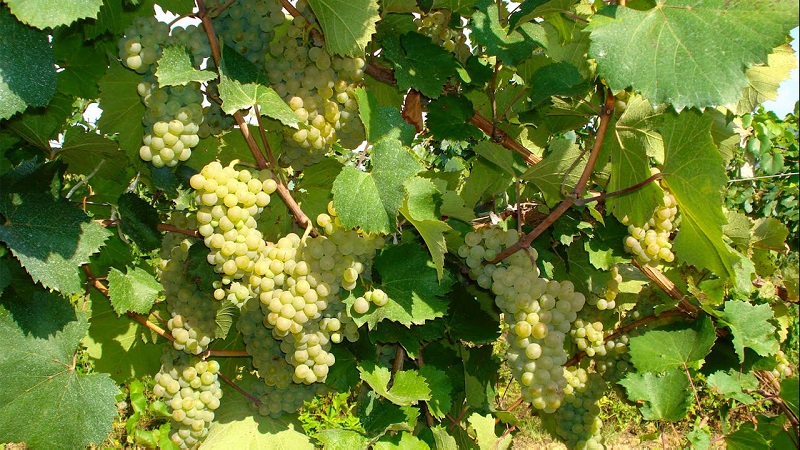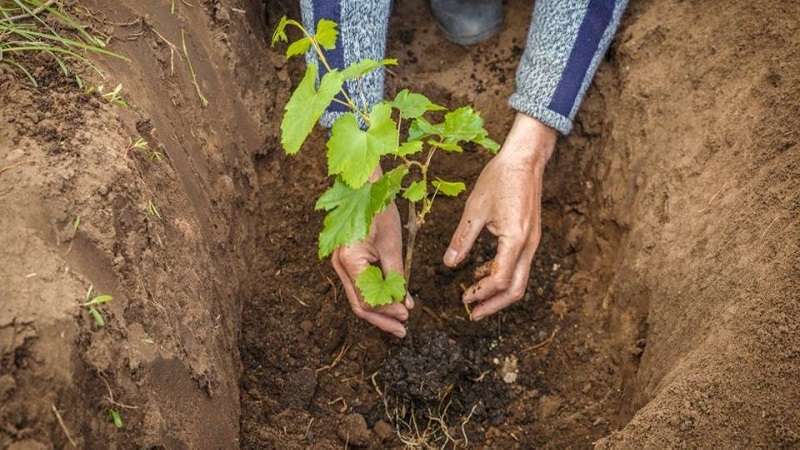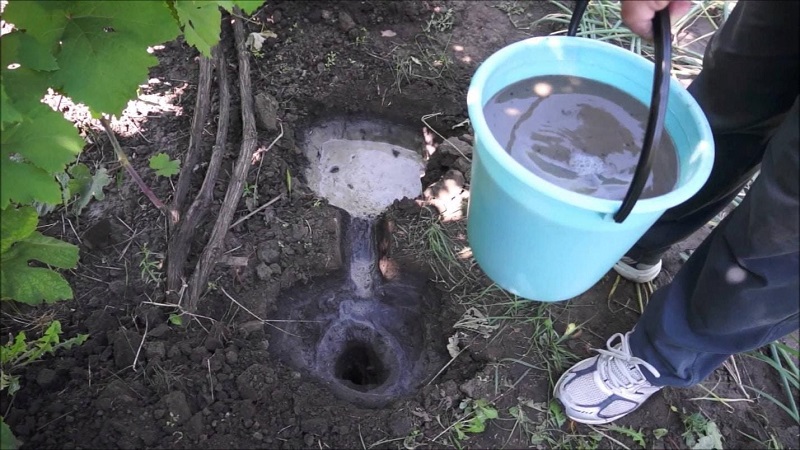Popular tasty grape variety "Aligote"
Aligote is a grape native to France. Farmers and gardeners immediately fell in love with this variety for its yield indicators, attractive commercial qualities, and unpretentious care. Grapes are grown in summer cottages and gardens. Aligote is used for making wines, juice, brandy, champagne. The juicy and tart taste of the grapes has come to the liking of many gardeners in Russia.
The content of the article
Description of the variety
Aligote is a popular grape variety in both the southern and northern regions... For what gardeners appreciate it and what to look for when growing, we will consider further.

Origin story
Aligote is a white wine variety originated in France in the 18th century... Like many French varieties, Aligote is mainly used for wine production: the berries are sweet and tart. Today this grape is cultivated not only in French lands, but also in Bulgaria, Romania, Moldova, Russia, Ukraine.
Description of the vine and fruit
Shoots are reddish brown... The leaves are medium in size, with subtle veins on the inside. In autumn, the leaves turn lemon yellow. The vine is an annual type. The bunches are outwardly similar to other varieties: they have short legs, an elongated cylindrical shape. The mass of one bunch is 100-130 g.
The berries are small, weighing 1–1.5 g. The color is green-yellow with light tints. The skin is thin but firm. The pulp is firm, tender and juicy. What is the taste of Aligote grapes? Sweet, tart, with fruity and herbal notes. The aroma is intense. One berry contains from 1 to 3 small seeds.

Frost and drought resistance
Aligote grapes has medium resistance to frost, rain, drought, sudden changes in weather... Gardeners recommend growing it in warm regions - Moscow region, Krasnodar Territory, Volga region. The variety is popular in the CIS countries: the climate there is moderate, without sudden cold snaps.
To get a good harvest for Aligote in the northern regions (in the Urals and Siberia), it is recommended carry out additional preventive and protective measures: apply mineral and organic fertilizing, cover plants from winds and fogs with film or agrofibre, treat against diseases and pests.
Attention! The resistance to insects and diseases of the variety is average. Grapes are affected by spider mites, aphids, downy mildew. The reasons for their appearance are different: non-compliance with the rules of care, inappropriate landing site, contaminated land, untimely prevention.
Flowering and ripening period
 The variety is mid-season - the ripening period lasts from 130 to 150 days depending on growing conditions.
The variety is mid-season - the ripening period lasts from 130 to 150 days depending on growing conditions.
The flowering period is in late May or early June and takes 8-15 days... It starts from the base and gradually spreads to the entire inflorescence.
If flowering is weak, gardeners stimulate it with the help of agrotechnical preparations "Bud" or "Ovary". They strengthen vineyards, protect against infectious diseases, and stimulate the ripening of fruits.
Yield
Aligote yield is stable... With proper care and compliance with all agrotechnical recommendations, 4-6 kg of grapes are harvested from one bush. Some specimens yield up to 10 kg.
Advantages and disadvantages
Of the merits, the taste and commercial qualities of grapes are noted... Planting and care does not require special skills - the variety is unpretentious. The advantages also include a stable yield and vitamin composition of the fruits. However, Aligote does not tolerate frost well - for cultivation in the northern regions of Russia, it needs additional nutrition and protection.
Is wine made from this variety
Aligote great for making dry white wines... The variety is characterized by a floral-fruity bouquet with herbal notes. Differs in high acidity, so it is better to drink wine young. The berries are used to prepare vintage table wines and blended wine materials.
Other grape varieties:
Planting seedlings
A lot depends on landing: livability of a plant, its immunity, ripening time, taste and marketability of fruits. Therefore, it is better to prepare for the procedure in advance.
Timing
A favorable season for planting grape seedlings - spring... The appropriate temperature is + 15 ° C, in such conditions the seedling takes root faster in the soil.
Gardeners start planting crops from March 15 to May 20... The further south the region is, the earlier Aligote will land. For example, in Krasnodar it may be March 20, and in Novosibirsk - May 20 (since the northern lands warm up more slowly).
Instructions
Choose healthy seedlings, which are determined by the white color of the root cut... The cutting is cut from the bottom so as to leave 1 cm to the first bud or about 2 cm at the top. The cuttings are soaked for a day in a solution of honey, then dried thoroughly.

Aligote planted in clay-lime or chestnut soils, light and clean, with neutral acidity. There should be no drafts on the site. The land is cleared of debris, last year's foliage and grass. They dig a hole 80x80 cm in size, put gravel on the bottom and place a wooden plank. Some create an additional layer of potash fertilizers and wood ash. The soil from the pit is separately mixed with fertilizers (superphosphate, infusion of mullein or wood ash).
The seedling is dipped into a composition of clay and mullein, then placed in a hole and sprinkled previously fertilized soil. Pour abundantly with water at room temperature, after 2-3 for mulch.
Attention! It is better to mulch grapes with straw, branches, stepsons, leaves, grass. This will protect the plants from weeds and do not have to weed frequently. It is important to keep the mulch slightly damp by watering or spraying regularly.
Subtleties of further care
Caring for Aligote grapes necessarily includes watering and feeding... They guarantee a strong plant immunity and a rich harvest.
Irrigation intensity
During the season, the grapes are watered 2-3 times, focusing on the appearance of the plant and weather conditions... If the leaves are drooping and thin, lose their color, the grapes lack moisture. Water it in the evening using water heated in the sun during the day. There is a risk of fungus or infection from cold liquid.
During the period of budding and ripening of berries, grapes especially need moisture... If the plants are planted in rows, water is poured into the furrows so that it gets to the roots faster. If the grapes are grown one at a time, water is poured into the circular grooves at the base of the trunk. After the furrow or groove, it is sprinkled with soil - this helps the moisture to stay in the ground longer and not evaporate. 1 m² requires about 50 liters of water.
Attention! Waterlogging is just as dangerous for Aligote grapes as a lack of liquid. With excess moisture, nutrients are washed out of the soil, the root system rots, which causes the entire plant to die. It is important to observe the rates and timing of watering.
Fertilizer
Fertilize grapes 2-3 times per season... The first feeding is in the spring, so that the crop will bear fruit well in the summer. The second is introduced before flowering. Nitrogen is used for the development of vines and leaves, phosphorus is used for healthy and fast flowering. In addition, grapes need calcium, copper, and iron.

Fertilizers are applied at the level of the location of the main roots... Experienced gardeners use a simple and effective method: when planting next to a seedling, they dig in a pipe through which they water and fertilize the grapes in the future. Plastic pipes with a diameter of about 10 cm are suitable for this. They are placed at a distance of 5 cm from the plant and at a depth of 40 cm. The plants are watered before each feeding.
Used as fertilizers ammonium nitrate, potassium sulfate, ash, mullein. Effectively affect the development of fruits and complex fertilizers: "Solution", "Novofert", "Aquarin". Do not forget about foliar dressing - so the nutrients are quickly absorbed by the leaves. Prepare solutions for spraying from zinc, boron, copper.
Read also:
Disease and pest control
Diseases occur both on young seedlings and on adult plants. To prevent them, it is important to carry out preventive work on time:
- Downy mildew (mildew) grapes are sprayed with Bordeaux liquid or the preparation "Polychom". The first time planting is processed before flowering, then after the appearance of the first fruits. For prophylaxis, dill is planted in the aisles - aromatic greens help fight mildew pathogens.
- In the fight against oidium use chemicals "Thanos" or "Topaz". The grapes are sprayed in the morning or evening, following the instructions. They help in the prevention and control of watering with an infusion of cut grass.
- Against gray mold use spraying with a solution based on 5% iodine (1 ml is taken for 1 liter of water). Grapes are processed once every 10 days, in dry and calm weather.

Of the pests, Aligote is susceptible to grape mites, thrips, worms, cicadas... Insects appear in the garden if the microflora of the earth is disturbed or the growing conditions are not met.
In the fight against pests, spraying with a 0.5% solution of chlorophos, preparations "Omite", "Fufanon", "Neoron" is used. Prevention is the removal of weeds, hilling, foliar top dressing.
Harvesting and storage
Harvested in late August or early September. Cut bunches ripen during storage, so it is undesirable to delay harvesting. The berries are removed in the morning when they are saturated with moisture and smell fragrant. If you do this in the evening, there is a high probability that the skin will be hard and the fruits will not retain marketability and taste.
Reference. The ripeness of the grapes is determined by the shape and size of the bunches and the color of the fruit. The skin acquires an appetizing golden hue and becomes thinner. The berries are easily detached from the branch, the stem is covered with a thin brown bloom.
Grapes ripen unevenly, so it is better to harvest gradually, in several stages. The berries are removed with gloves so as not to damage the wax layer. Old and withered leaves are removed from the bunches.
For harvest storage a darkened ventilated room with 80% humidity is suitable. Keep the fruits on shelves or hung on a wire.
Similar varieties
In addition to Aligote, gardeners are experimenting and planting other wine and delicious grape varieties on the site. Consider some of the most popular:
- Chardonnay... World renowned white grapes are prized for their sweet taste and tart aftertaste. The bunch is cylindrical, weighing about 100 g. The berries are oval, about 15 mm in diameter. They are yellow or green, depending on the variety. In Russia, Chardonnay is grown only in very warm regions, since it does not tolerate frost and cold winds well.
- Bianca... Hungarian grape variety is suitable for cultivation in Russia, Belarus, Ukraine. Plants are semi-sprawling of medium size. The weight of the bunch is about 200 g, the weight of one berry varies from 2 to 7 g. The shape of the fruit is spherical, the color is light green with a yellow tint.
- Kokur white... The universal variety is distinguished by its unpretentious cultivation.A bunch of conical shape, weighing from 150 to 200 g. Berries are large, rounded. The color is yellow-green, there is a slight bloom on the fruits. Sweet fruity taste. The berries are used for the production of grape juice, champagne, and cognac.
Conclusion
The tart Aligote grapes are planted in the spring, having prepared a place for planting in advance. Cuttings are processed and placed in wells, mulched and watered with warm water. Mineral and organic fertilizing helps to accelerate the development of fruits.
To protect plantings from diseases and pests, preventive measures are taken, plants are sprayed with Bordeaux liquid. The grapes are harvested in late summer or early autumn as the fruits ripen. The crop is used for making drinks or consumed fresh.